Caryn’s Thoughts

 Since my nephew, Garrett Stevens’ wife, Kayla was hired to work as a social worker in a therapy clinic in Sheridan, Wyoming, they have been busily planning their move. Garrett is still working here in Casper, and will start looking for work in Sheridan when they get moved up there. Kayla has been house hunting, and has found a great house for them to buy, so everything is falling into place for their move. I know that they are going to be very successful living in Sheridan, and since Kayla’s family lives there, they already have some leads for Garrett in his job search. Garrett is a great welder, and will be an asset to any company. I’m sure that he will find a great job quickly. I know that with this move comes the excitement of a new adventure…a new chapter in their lives.
Since my nephew, Garrett Stevens’ wife, Kayla was hired to work as a social worker in a therapy clinic in Sheridan, Wyoming, they have been busily planning their move. Garrett is still working here in Casper, and will start looking for work in Sheridan when they get moved up there. Kayla has been house hunting, and has found a great house for them to buy, so everything is falling into place for their move. I know that they are going to be very successful living in Sheridan, and since Kayla’s family lives there, they already have some leads for Garrett in his job search. Garrett is a great welder, and will be an asset to any company. I’m sure that he will find a great job quickly. I know that with this move comes the excitement of a new adventure…a new chapter in their lives.
The first years of their relationship, and this first year of their marriage have been spent with Kayla as a student. As anyone who has a masters degree knows, that means lots of studying. Of course, Garrett was supportive of Kayla in her studies, but now that the education time is behind them, I think they will have lots more time to do the fun things they like to do, and for starting a family in the future. That makes the next chapter of their lives very exciting. Things like becoming homeowners, and working in the careers that they have both studied for and enjoy, will make this new chapter very exciting for them.
Garrett loves doing outdoorsy things like camping, hunting, and fishing. He loves sports…all kinds of sports. But he is also very much a family sort of guy. He has been a great older cousin to all of his cousins. They love to hang out with Garrett, because he isn’t too “old” to play with them. So often, people who don’t have children, 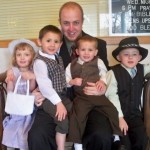
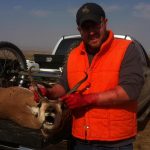 would rather that other people’s kids would just stay away, but not Garrett. He would love to have a dozen kids around him at any given moment, and it’s ok if they are crawling all over him too. He just takes it all in stride, or maybe like most kids, rough housing is the order of the day. And he loves babies as much as the older kids. Crying is not a problem. He will sooth them and before you know it, they are calm or sleeping. Garrett will make a great dad some day, but that is a completely different new chapter. Today is Garrett’s birthday. Happy birthday Garrett!! Have a great day!! We love you!!
would rather that other people’s kids would just stay away, but not Garrett. He would love to have a dozen kids around him at any given moment, and it’s ok if they are crawling all over him too. He just takes it all in stride, or maybe like most kids, rough housing is the order of the day. And he loves babies as much as the older kids. Crying is not a problem. He will sooth them and before you know it, they are calm or sleeping. Garrett will make a great dad some day, but that is a completely different new chapter. Today is Garrett’s birthday. Happy birthday Garrett!! Have a great day!! We love you!!
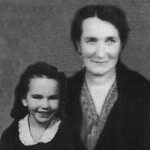 My cousin, Shirley Cameron is the first granddaughter of my grandmother, Anna Louise Schumacher Spencer and grandfather, Allen Luther Spencer, and would remain the only granddaughter for nearly the first seven years of her life. As the first granddaughter, and the only one for so long, she and my grandmother became quite close. Grandma passed away when I was just six months old, so I never really got to know her. Nevertheless, Shirley has told me a few things about Grandma that give me a bit of a view of her…humorous side. Kids tend to get into trouble with their parents, and Shirley is no different, but Shirley had a bit of an edge when it came to getting in trouble with her mom. She would run to her Grandma Spencer, who would teasingly shield her from her mother’s wrath. It’s one thing to plan to spank your child, but when your mother gets in the middle of things and makes the whole thing seem like a game of chase, it sometimes becomes impossible…not to laugh, that is.
My cousin, Shirley Cameron is the first granddaughter of my grandmother, Anna Louise Schumacher Spencer and grandfather, Allen Luther Spencer, and would remain the only granddaughter for nearly the first seven years of her life. As the first granddaughter, and the only one for so long, she and my grandmother became quite close. Grandma passed away when I was just six months old, so I never really got to know her. Nevertheless, Shirley has told me a few things about Grandma that give me a bit of a view of her…humorous side. Kids tend to get into trouble with their parents, and Shirley is no different, but Shirley had a bit of an edge when it came to getting in trouble with her mom. She would run to her Grandma Spencer, who would teasingly shield her from her mother’s wrath. It’s one thing to plan to spank your child, but when your mother gets in the middle of things and makes the whole thing seem like a game of chase, it sometimes becomes impossible…not to laugh, that is.
Our grandmother spent part of her time in a wheelchair, due to Rheumatoid Arthritis, and Shirley remembers climbing up on her lap and tearing around the house with much screaming, of excitement that is, while her mother most likely sported a headache from all the noise, but I must admit, I would probably find it quite fun to ride around the house on Grandma’s lap in her wheelchair. I also think that while Grandma and Shirley might have ganged up on Aunt Ruth, and Grandma might have helped Shirley get away with a few things, Aunt 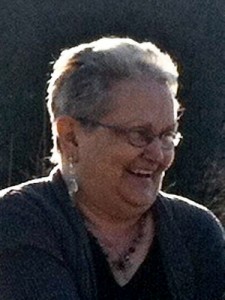 Ruth probably also loved watching the two of them being so close. I suppose that could be the grandma in me talking, because I loved being so close to my grandchildren. It is a privilege that is simply priceless. Nevertheless, I think my grandkids liked it too. There is just something wonderful about being close to your grandparents.
Ruth probably also loved watching the two of them being so close. I suppose that could be the grandma in me talking, because I loved being so close to my grandchildren. It is a privilege that is simply priceless. Nevertheless, I think my grandkids liked it too. There is just something wonderful about being close to your grandparents.
As with most of us, those childhood days have long since turned into childhood memories. Both Grandma and Aunt Ruth have been in Heaven now for many years, but Shirley will always have the memories of those amazing fun times, and that is something most of the rest of us will never have, because we were either too little, or not born yet, when our grandma passed away, with the exception of three of the grandsons. Knowing Grandma is something I wish I had been able to do too, but I love hearing about the good times Shirley and Grandma had. Today is Shirley’s 70th birthday. Happy birthday Shirley!! Have a great day!! We love you!!
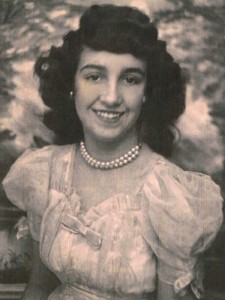 For much of her life, my Aunt Virginia Beadle was a working woman. She spent time working for the telephone company, and also for the State of Wyoming. I remember seeing her sometimes all dressed up for work, and thinking that she looked so sophisticated. I wanted to dress up like her…to look like a real lady, and as an adult, I have spent many years in the working world too, where I have always remembered just how nice my Aunt Virginia looked. I have tried to keep that picture of the sophisticated lady that she always was in my mind in my own career. I have felt that a successful working woman was always stylish, whether wearing a dress or pants. For some reason that stuck out more to me than the actual work the woman did. I suppose that was the little girl in me remembering how stylish Aunt Virginia was.
For much of her life, my Aunt Virginia Beadle was a working woman. She spent time working for the telephone company, and also for the State of Wyoming. I remember seeing her sometimes all dressed up for work, and thinking that she looked so sophisticated. I wanted to dress up like her…to look like a real lady, and as an adult, I have spent many years in the working world too, where I have always remembered just how nice my Aunt Virginia looked. I have tried to keep that picture of the sophisticated lady that she always was in my mind in my own career. I have felt that a successful working woman was always stylish, whether wearing a dress or pants. For some reason that stuck out more to me than the actual work the woman did. I suppose that was the little girl in me remembering how stylish Aunt Virginia was.
Of course, Aunt Virginia’s look and her clothes were not what made her a great employee, but rather the fact that she was very good at her jobs. I can’t say that I know all the details of what her job entailed, but just the fact that she held her jobs so long and that she was very much respected at her workplace, tells me that she was an amazing worker too. People don’t have respect for a worker who doesn’t do their job, and I happen to know that she as a hard working woman. She was respected and well liked at her job, so that tells me that she was very good at it.
 Aunt Virginia has always been a stylish woman, whether at work or at home, and while she was very good at her jobs, her real life was her family. She loves her kids, and she has been very blessed with many grandchildren and great grandchildren. I really love seeing her with those babies, because her eyes just sparkle. Being the second oldest of my grandparents’ children, Aunt Virginia will also, at this birthday, become the one who has lived the longest. That has afforded her the great pleasure of lots of new babies to cuddle with. I love seeing her with all of those babies, because she just seems to be totally in her element. It is a sweet thing to watch, as is her interaction with all of her nieces and nephews. Today is Aunt Virginia’s 87th birthday. Happy birthday Aunt Virginia!! Have a great day!! We love you!!
Aunt Virginia has always been a stylish woman, whether at work or at home, and while she was very good at her jobs, her real life was her family. She loves her kids, and she has been very blessed with many grandchildren and great grandchildren. I really love seeing her with those babies, because her eyes just sparkle. Being the second oldest of my grandparents’ children, Aunt Virginia will also, at this birthday, become the one who has lived the longest. That has afforded her the great pleasure of lots of new babies to cuddle with. I love seeing her with all of those babies, because she just seems to be totally in her element. It is a sweet thing to watch, as is her interaction with all of her nieces and nephews. Today is Aunt Virginia’s 87th birthday. Happy birthday Aunt Virginia!! Have a great day!! We love you!!
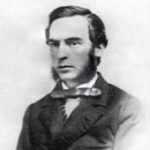
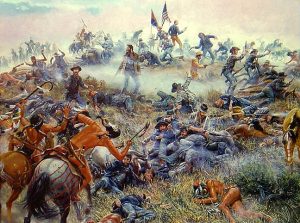 These days, as wars are fought, we often see, hear, and read the stories written by embedded reporters. It seems almost commonplace, and yet in reality, whenever these reporters go into a war zone, they are risking almost as much as the soldiers. Of course, the reporters don’t go out to attack the enemy, but because of where they are, and who they are with, they make themselves a target to the enemy too. Even as far back as the World Wars, embedded reporters seemed like a common phenomenon, but who would have thought of an embedded reporter as far back as the Indian wars? I certainly didn’t. Nevertheless, journalists were there. One such journalist, who became famous, mostly because he was killed, was Marcus Kellogg, who was traveling with Custer’s 7th Cavalry. Kellogg was a native of Ontario, Canada before immigrating to New York with his family in 1835. As a young man he mastered the art of the telegraph and went to work for the Pacific Telegraphy Company in Wisconsin. During the Civil War, he felt led toward a different calling. He left his career in telegraphy, and became a journalist. Then in 1873, he again felt the calling to change his life, when he decided to move west to the frontier town of Bismarck in Dakota Territory and became the assistant editor of the Bismarck Tribune.
These days, as wars are fought, we often see, hear, and read the stories written by embedded reporters. It seems almost commonplace, and yet in reality, whenever these reporters go into a war zone, they are risking almost as much as the soldiers. Of course, the reporters don’t go out to attack the enemy, but because of where they are, and who they are with, they make themselves a target to the enemy too. Even as far back as the World Wars, embedded reporters seemed like a common phenomenon, but who would have thought of an embedded reporter as far back as the Indian wars? I certainly didn’t. Nevertheless, journalists were there. One such journalist, who became famous, mostly because he was killed, was Marcus Kellogg, who was traveling with Custer’s 7th Cavalry. Kellogg was a native of Ontario, Canada before immigrating to New York with his family in 1835. As a young man he mastered the art of the telegraph and went to work for the Pacific Telegraphy Company in Wisconsin. During the Civil War, he felt led toward a different calling. He left his career in telegraphy, and became a journalist. Then in 1873, he again felt the calling to change his life, when he decided to move west to the frontier town of Bismarck in Dakota Territory and became the assistant editor of the Bismarck Tribune.
Then, while returning from a trip to the East, Kellogg happened to be on the same train as George Custer and his wife, Elizabeth. Custer was on his way to Fort Abraham Lincoln, near Bismarck, where he was going to lead the 7th Cavalry in a planned assault on several bands of Indians who had refused to be confined to reservations. There journey was delayed by an unusually heavy winter storm. The train became snowbound. Being the expert that he was, Kellogg improvised a crude telegraph key, connected it to the wires running alongside the track, and sent a message ahead to the fort asking for help. Custer’s brother, Tom, arrived soon after with a sleigh to rescue them. Custer had enjoyed being made famous by the nation’s newspapers during the Civil War, and now, as he prepared for what he hoped would be his greatest victory ever, Custer wanted to make sure his glorious deeds would be adequately covered in the press. Initially, Custer had planned to take his old friend Clement Lounsberry, who was Kellogg’s employer at the Tribune, with him into the field with the 7th Cavalry, but after meeting Kellogg, he chose him to go instead, mostly because Custer had been impressed by his resourcefulness with a telegraph key.
That one chance event in the winter of 1876, took Kellogg in an unexpected direction…toward the Little Big Horn. When Custer led his soldiers out of Fort Abraham Lincoln and headed west for Montana on May 31, Kellogg rode with him. During the next few weeks, Kellogg filed three dispatches from the field to the Bismarck Tribune, which in turn passed the stories on to the New York Herald. Wanting to make sure the word got out, Custer also sent three anonymous reports on his progress to the Herald. Kellogg’s first dispatches, dated May 31 and June 12, recorded the progress of the expedition westward. His final report, dated June 21, came from the army’s camp along the Rosebud River in southern Montana, not far from the Little Big Horn River. “We leave the Rosebud tomorrow,” Kellogg wrote, “and by the time this reaches you we will have met and fought the red devils, with what result remains to be seen.” The results, of course, were disastrous. Four days later, Sioux and Cheyenne warriors wiped out Custer and his men along the Little Big Horn River. Kellogg was the only journalist to witness the final moments of Custer’s 7th Cavalry. Had he been able to file a story he would have become a national celebrity, but Kellogg did not live to tell the tale, he died alongside Custer’s soldiers.
On July 6, the Bismarck Tribune printed a special extra edition with a top headline reading: “Massacred: Gen. Custer and 261 Men the Victims.” Further down in the column, in substantially smaller type, a sub-headline reported: “The Bismarck Tribune’s Special Correspondent Slain.” The article went on to report, “The body of Kellogg alone remained unstripped of its clothing, and was not mutilated.” The reporter speculated that this 
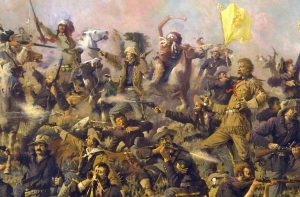 might have been a result of the Indian’s “respect for this humble shover of the lead pencil.” I doubt that the Sioux and Cheyenne respected Kellogg for his journalistic abilities, but his death in one of the most notorious events in the nation’s history made him something of an martyr among newspapermen. The New York Herald later erected a monument to Kellogg over the supposed site of his grave on the Little Big Horn battlefield. Being an embedded journalist might be exciting, but it’s quite risky too.
might have been a result of the Indian’s “respect for this humble shover of the lead pencil.” I doubt that the Sioux and Cheyenne respected Kellogg for his journalistic abilities, but his death in one of the most notorious events in the nation’s history made him something of an martyr among newspapermen. The New York Herald later erected a monument to Kellogg over the supposed site of his grave on the Little Big Horn battlefield. Being an embedded journalist might be exciting, but it’s quite risky too.
 I read somewhere that the Sunday before Father’s Day is Write a Letter to your Father Day, and I found myself wishing this was a day I had known about a long time ago, because while Father’s Day is traditionally a day on which we show our dads that we love and appreciate them, Write a Letter to your Father Day, in my opinion really had a far deeper meaning in so many ways. Looking back on my life, there are so many things I would love to thank my dad for, and indeed, my parents for, but since this is about dads, I’ll take this one step at a time. Since my dad, Allen Spencer is in Heaven now, my letter will not be able to be sent or received, so I’m sure my dad won’t mind if this is all done in cyberspace.
I read somewhere that the Sunday before Father’s Day is Write a Letter to your Father Day, and I found myself wishing this was a day I had known about a long time ago, because while Father’s Day is traditionally a day on which we show our dads that we love and appreciate them, Write a Letter to your Father Day, in my opinion really had a far deeper meaning in so many ways. Looking back on my life, there are so many things I would love to thank my dad for, and indeed, my parents for, but since this is about dads, I’ll take this one step at a time. Since my dad, Allen Spencer is in Heaven now, my letter will not be able to be sent or received, so I’m sure my dad won’t mind if this is all done in cyberspace.
Dear Dad, Words can never really express how deeply blessed I feel to have been born your daughter. I came home to a house filled with love, and parents who raised me and my sisters in God’s ways. We learned the basics, of course, have faith in God, share with others, helpout around the house, have respect for our parents and those in authority, and to always be honorable in all things. We always knew that no matter what, we were a family, and family came first. We learned that there was nothing we could ever do to lose your love for us, and that no matter how badly we messed up, we could always come to our parents for help and guidance. The one thing we never received from you was judgment and condemnation, because those things are totally out of 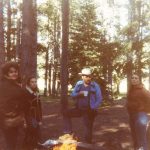 character with love, and you totally loved your family.
character with love, and you totally loved your family.
Over the years, you showed us this great country we live in and taught us to love camping and all kinds of travel. You kept the fires going to scare away the bears, because we thought it would work, and you never made us feel silly for suggesting such a crazy thing. As we grew to our teen years, you understood that getting five girls ready in the morning was not a simple matter, but rather a two hour ordeal, while you patiently waited drinking a cup of coffee. There was so much you wanted to show us, but we were girls, and while we wanted to see most of it, vacation simply did not mean that we went out in public, sans makeup. Dad, you were so outnumbered, all of your married life, but you always seemed to take it in stride.
You and Mom taught us how a marriage and family should look, and how parents should raise their kids. Our families have been enriched by the family life we lived as kids. You always wanted your family around you, and Dad you made sure that if we got busy in our lives, we didn’t forget to come and have lunch with you and Mom. It kept us connected. You loved to hear about our lives, our work, our kids, our husbands. You wanted to 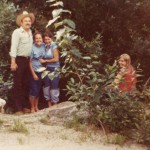 be a part of our lives, but you were never intrusive…just interested. I always loved that about you and Mom, and those lunches will always have a very special place in my memory files. They were among the sweetest memories.
be a part of our lives, but you were never intrusive…just interested. I always loved that about you and Mom, and those lunches will always have a very special place in my memory files. They were among the sweetest memories.
Dad, I could go on and on about how wonderful you and Mom made our lives, but I guess that will be a letter for another day. I just want to thank you for making life for my sisters and me, the most wonderful kind of life in the world. We have been so wonderfully blessed by God when he made you and Mom our parents. Today isn’t a traditional special day, but really just a day to let you know that I am thinking of you always. I love you so much, Dad. Your daughter, Caryn.
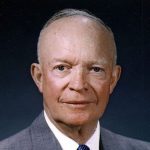 In any wartime situation, there always seem to be those who think the United States should not get involved…mostly because they think that if we just stay out of it, the enemy will leave us alone. Of course, history does not prove that theory. When we look at the wars that the United States has been drawn into, only after we were attacked too, we find that the enemy always intended to take on the United States too, and we were only delaying the inevitable. It seems like every wartime president has had to deal with the naysayers, and President Eisenhower was no different. During the Cold War years when the Communists were trying to take over the world, Eisenhower chose a strong United States defense against it, but his view of a strong defense was much different that General Hoyt Vandenberg’s view. Vandenberg wanted a massive increase in conventional land, air, and sea forces, while Eisenhower said that a cheaper and more efficient defense could be built around the nation’s nuclear arsenal. Senator Robert Taft argued that if efforts to reach a peace agreement in Korea failed, the United States should withdraw from the United Nations forces and make its own policy for dealing with North Korea, basically a completely independent foreign policy, or what one “might call the ‘fortress’ theory of defense.” While both of these suggestions might seem like the best course of action, history tells us that Senator Taft’s suggestion would make us look weak, and possibility bring about attacks on the United States, and while I would tend to agree with General Vandenberg, that we need a strong defense system, I also understand that as technology changes, nations must change with it. Having hundreds of fighter planes is not necessary, if a few can drop a bomb that will settle the matter once and for all. It is similar to the use of pen and paper when we live in a computer age.
In any wartime situation, there always seem to be those who think the United States should not get involved…mostly because they think that if we just stay out of it, the enemy will leave us alone. Of course, history does not prove that theory. When we look at the wars that the United States has been drawn into, only after we were attacked too, we find that the enemy always intended to take on the United States too, and we were only delaying the inevitable. It seems like every wartime president has had to deal with the naysayers, and President Eisenhower was no different. During the Cold War years when the Communists were trying to take over the world, Eisenhower chose a strong United States defense against it, but his view of a strong defense was much different that General Hoyt Vandenberg’s view. Vandenberg wanted a massive increase in conventional land, air, and sea forces, while Eisenhower said that a cheaper and more efficient defense could be built around the nation’s nuclear arsenal. Senator Robert Taft argued that if efforts to reach a peace agreement in Korea failed, the United States should withdraw from the United Nations forces and make its own policy for dealing with North Korea, basically a completely independent foreign policy, or what one “might call the ‘fortress’ theory of defense.” While both of these suggestions might seem like the best course of action, history tells us that Senator Taft’s suggestion would make us look weak, and possibility bring about attacks on the United States, and while I would tend to agree with General Vandenberg, that we need a strong defense system, I also understand that as technology changes, nations must change with it. Having hundreds of fighter planes is not necessary, if a few can drop a bomb that will settle the matter once and for all. It is similar to the use of pen and paper when we live in a computer age.
President Eisenhower was no stranger to sending the military might of the United States out to attack the enemy, and in his days as a general, he made those decisions every day, but as every one should realize, the  more men you have to send, the more possibility of losing them. The decision to send soldiers to their deaths was not one that Eisenhower ever took lightly. With a strong nuclear arsenal, the enemy nation knew that they had better think twice before taking on the United States.
more men you have to send, the more possibility of losing them. The decision to send soldiers to their deaths was not one that Eisenhower ever took lightly. With a strong nuclear arsenal, the enemy nation knew that they had better think twice before taking on the United States.
Without naming either man, President Eisenhower responded to both during a speech at the National Junior Chamber of Commerce meeting in Minneapolis. His forceful speech struck back at critics of his Cold War foreign policy. He insisted that the United States was committed to the worldwide battle against communism and that he would maintain a strong United States defense. It was just a few months into his presidency, and the Korean War still raging, but Eisenhower laid out his basic approach to foreign policy with this speech. He began by characterizing the Cold War as a battle “for the soul of man himself.” He rejected Taft’s idea that the United States should pursue isolationism, and instead he insisted that all free nations had to stand together saying, “There is no such thing as partial unity.” To Vandenberg’s criticisms of the new Air Force budget, in which the president proposed a $5 billion cut from the Air Force budget, Eisenhower explained that vast numbers of aircraft were not needed in the new atomic age. Just a few planes armed with nuclear weapons could “visit on an enemy as much explosive violence as was hurled against Germany by our entire air effort throughout four years of World War II.” With this speech, Eisenhower thus pointed out the two major points of what came to be known at the time as his “New Look” foreign policy. First was his advocacy of multi-nation responses to communist aggression in preference to unilateral action by the United States. Second was the idea that came to be known as the “bigger bang for the buck” defense strategy.
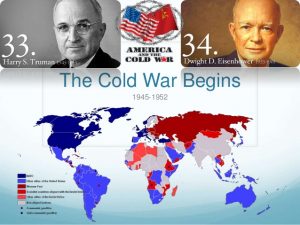 Anytime a nation is facing war, it is a stressful time for its people, but no nation will do well using the isolation strategy, because a nation that appears to be weak in its own defense, will ultimately become a target for attack. I am not an advocate for the United Nations, and in fact, I believe we need to disband the United Nations, but I do believe that a nation must have allies…nations with like values, who are willing to go to war to back up their allies, and that we must not allow bully nations to take over smaller nations, because that only strengthens their resolve to expand further. I also believe that when technology becomes available, it must be properly combined with human forces to achieve the best result in the most efficient way.
Anytime a nation is facing war, it is a stressful time for its people, but no nation will do well using the isolation strategy, because a nation that appears to be weak in its own defense, will ultimately become a target for attack. I am not an advocate for the United Nations, and in fact, I believe we need to disband the United Nations, but I do believe that a nation must have allies…nations with like values, who are willing to go to war to back up their allies, and that we must not allow bully nations to take over smaller nations, because that only strengthens their resolve to expand further. I also believe that when technology becomes available, it must be properly combined with human forces to achieve the best result in the most efficient way.
 For most graduated college students, the next step is to look for a job in your field, and my niece, Kayla Stevens is no different. Since her graduation Kayla has sent résumés to several places in Casper, and in Sheridan, where she is from. It didn’t take very long for a therapy clinic in Sheridan to grab her up. When you have the grades she did, you become the pick of the litter of graduates. Things are happening pretty fast now. Kayla starts her new job in just ten days, and so she is working on finding a house for them to live in. I am not sure when her husband, Garrett, my nephew will be joining Kayla in Sheridan, but since she starts her job on June 19th, she will be in Sheridan before we have hardly had a chance to blink. I know how hard this will be for my sister, Alena Stevens, and her husband Mike, but of
For most graduated college students, the next step is to look for a job in your field, and my niece, Kayla Stevens is no different. Since her graduation Kayla has sent résumés to several places in Casper, and in Sheridan, where she is from. It didn’t take very long for a therapy clinic in Sheridan to grab her up. When you have the grades she did, you become the pick of the litter of graduates. Things are happening pretty fast now. Kayla starts her new job in just ten days, and so she is working on finding a house for them to live in. I am not sure when her husband, Garrett, my nephew will be joining Kayla in Sheridan, but since she starts her job on June 19th, she will be in Sheridan before we have hardly had a chance to blink. I know how hard this will be for my sister, Alena Stevens, and her husband Mike, but of  course, Kayla’s family has been missing her since she came to Casper for college. Kayla and Garrett decided that she would apply in both cities, and go where God led them, so I know that this move and this job will be a great blessing for both of them.
course, Kayla’s family has been missing her since she came to Casper for college. Kayla and Garrett decided that she would apply in both cities, and go where God led them, so I know that this move and this job will be a great blessing for both of them.
Kayla has such a caring heart, and the patients whose lives she will impact are among the most blessed people around. She loves working with children, so I hope that she will be able to have some kids in that group too, because they would be very blessed to have her helping them with whatever they need. I don’t know what Kayla’s job will entail, but I know that with her abilities, she will be very successful at it, and I look forward to hearing more about it as time goes by. Of course, with social work, as with  any medical profession, privacy is the word of the day, so mostly we will hear about the general day to day work, and not about specific patients.
any medical profession, privacy is the word of the day, so mostly we will hear about the general day to day work, and not about specific patients.
Sheridan is a beautiful town, and since Kayla and Garrett love to camp, they will really enjoy the easy access to the Big Horn Mountains, and all the other outdoor activities Sheridan has to offer. The future will be a very exciting one for them as they settle in to their new jobs, and I’m sure someday soon, start a family. I know that my sister, Alena and her family will also have a lot of visits to Sheridan in their future. Kayla and Garrett will come to visit too, but we will all miss them very much anyway. Today is Kayla’s birthday. Happy birthday Kayla!! Have a great day!! We love you!!
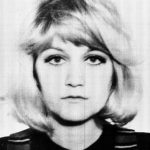 For most of us, taking a fall, of any kind is no fun. Taking a fall off of a one story roof is terrifying, and if we were to fall from a two story building, we might not expect to live through it. For Serbian flight attendant, Vesna Vulovic a two story fall is like stubbing her toe. On January 26, 1972, while she was working on JAT Flight 367, a terrorist bomb exploded on the plane. Vesna found herself in a freefall without a parachute at an altitude of 33,333 feet. Vulovic, who was just 22 years old, and thought she had landed a wonderful career that would allow her to travel to exotic places. Never in a million years did she imagine that her career would end this way.
For most of us, taking a fall, of any kind is no fun. Taking a fall off of a one story roof is terrifying, and if we were to fall from a two story building, we might not expect to live through it. For Serbian flight attendant, Vesna Vulovic a two story fall is like stubbing her toe. On January 26, 1972, while she was working on JAT Flight 367, a terrorist bomb exploded on the plane. Vesna found herself in a freefall without a parachute at an altitude of 33,333 feet. Vulovic, who was just 22 years old, and thought she had landed a wonderful career that would allow her to travel to exotic places. Never in a million years did she imagine that her career would end this way.
Flight 367 was flying over Srbská Kamenice in Czechoslovakia, which is now part of the Czech Republic. She had not been scheduled to be on that flight, but she had been mixed up with another flight attendant who was also named Vesna. I’m sure she wished she had not been as she was falling through the air that awful day in 1972. While falling 33,333 feet, a person has a good bit of time to think about what they wished they had done, or not done. And at 22, I’m sure there were many things she had hoped to accomplish in her lifetime, and now those things could never happen.
The official report of the Czechoslovak investigation commission, which was handed over to the ICAO on May 7, 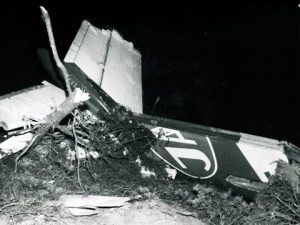 1974, stated that there had been an explosion in the front baggage compartment of the plane. The Czechoslovak secret service, which was leading the investigation, presented parts of an alarm clock ten days after the crash which they claimed came from a bomb. The report concluded that a bomb brought down Flight 367. That morning, an anonymous man called the newspaper Kvällsposten published in Malmö, Sweden, claiming, in broken Swedish, that he was a Croat and member of a nationalist group that placed the bomb on the plane. Shortly after the phone call, the Yugoslav government blamed the Ustaše. According to the official report the explosion tore the McDonnell Douglas DC-9-32 to pieces in mid-air. Vulovic was the only survivor.
1974, stated that there had been an explosion in the front baggage compartment of the plane. The Czechoslovak secret service, which was leading the investigation, presented parts of an alarm clock ten days after the crash which they claimed came from a bomb. The report concluded that a bomb brought down Flight 367. That morning, an anonymous man called the newspaper Kvällsposten published in Malmö, Sweden, claiming, in broken Swedish, that he was a Croat and member of a nationalist group that placed the bomb on the plane. Shortly after the phone call, the Yugoslav government blamed the Ustaše. According to the official report the explosion tore the McDonnell Douglas DC-9-32 to pieces in mid-air. Vulovic was the only survivor.
Vulovic suffered a fractured skull, three broken vertebrae, one of which was crushed completely, and that left her temporarily paralyzed from the waist down, and two broken legs. She was in a coma for 27 days. In an interview, she commented that according to the man who found her, “…I was in the middle part of the plane. I was found with my head down and my colleague on top of me. One part of my body with my leg was in the plane and my head was out of the plane. A catering trolley was pinned against my spine and kept me in the 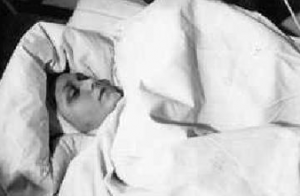 plane. The man who found her said she was lucky. He was in the German Army as a medic during World War II. He knew how to treat trauma. The medic is identified as Bruno Henke. Vulovic continued working for JAT Airways at a desk job following a full recovery from her injuries. She regained the use of her legs and continued to fly sporadically. She claimed she had no fear of flying, which she attributed to her loss of memory of the crash, and she even enjoyed watching movies with plane crashes. She was considered a national heroine throughout the former Yugoslavia and was awarded the Guinness Record title by Paul McCartney at a ceremony in 1985. As to becoming the world record freefall holder, Vesna comments, “I am like a cat, I have had nine lives.”
plane. The man who found her said she was lucky. He was in the German Army as a medic during World War II. He knew how to treat trauma. The medic is identified as Bruno Henke. Vulovic continued working for JAT Airways at a desk job following a full recovery from her injuries. She regained the use of her legs and continued to fly sporadically. She claimed she had no fear of flying, which she attributed to her loss of memory of the crash, and she even enjoyed watching movies with plane crashes. She was considered a national heroine throughout the former Yugoslavia and was awarded the Guinness Record title by Paul McCartney at a ceremony in 1985. As to becoming the world record freefall holder, Vesna comments, “I am like a cat, I have had nine lives.”
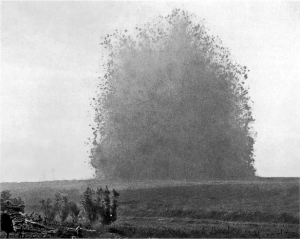 The manner in which battles are fought and won, never ceases to amaze me. In 1916, British forces began planning the Battle of Messines Ridge. For 18 months, soldiers worked to place nearly 1 million pounds of explosives in tunnels under the German positions. The tunnels extended to some 2,000 feet in length, and some were as much as 100 feet below the surface of the ridge, where the Germans had long since been entrenched. The Germans had no idea that they were there, and no idea what was going to happen. I find myself in complete amazement, that all those soldiers were working a mere 100 feet below ground, and the German soldiers above them had no idea. It was the element of surprise that was the whole key to this successful attack.
The manner in which battles are fought and won, never ceases to amaze me. In 1916, British forces began planning the Battle of Messines Ridge. For 18 months, soldiers worked to place nearly 1 million pounds of explosives in tunnels under the German positions. The tunnels extended to some 2,000 feet in length, and some were as much as 100 feet below the surface of the ridge, where the Germans had long since been entrenched. The Germans had no idea that they were there, and no idea what was going to happen. I find myself in complete amazement, that all those soldiers were working a mere 100 feet below ground, and the German soldiers above them had no idea. It was the element of surprise that was the whole key to this successful attack.
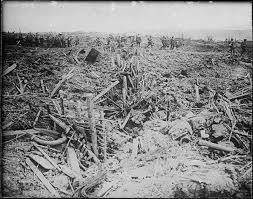 At 3:10am on June 7, 1917, a series of simultaneous explosions rocked the area. The explosions were heard as far away as London. A German observer described the explosions saying, “nineteen gigantic roses with carmine petals, or enormous mushrooms, rose up slowly and majestically out of the ground and then split into pieces with a mighty roar, sending up multi-colored columns of flame mixed with a mass of earth and splinters high in the sky.” While Messines Ridge itself was considered a relatively limited victory, it had a considerable effect. German losses that day included more than 10,000 men who died instantly, along with some 7,000 prisoners…men who were too stunned and disoriented by the explosions to resist the infantry assault.
At 3:10am on June 7, 1917, a series of simultaneous explosions rocked the area. The explosions were heard as far away as London. A German observer described the explosions saying, “nineteen gigantic roses with carmine petals, or enormous mushrooms, rose up slowly and majestically out of the ground and then split into pieces with a mighty roar, sending up multi-colored columns of flame mixed with a mass of earth and splinters high in the sky.” While Messines Ridge itself was considered a relatively limited victory, it had a considerable effect. German losses that day included more than 10,000 men who died instantly, along with some 7,000 prisoners…men who were too stunned and disoriented by the explosions to resist the infantry assault.
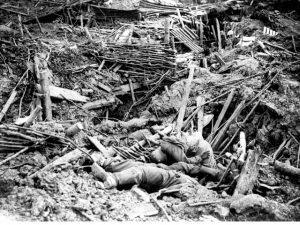
It was a crushing victory over the Germans. The German army was forced to retreat to the east. This retreat and the sacrifice that it entailed marked the beginning of their gradual, but continuous loss of territory along the Western Front. It also secured the right flank of the British army’s push towards the much-contested Ypres region, which was the eventual objective of the planned attack. Over the next month and a half, British forces continued to push the Germans back toward the high ridge at Passchendaele. Then on July 31 the British army launched it’s offensive, known as the Battle of Passchendaele or the Third Battle of Ypres.

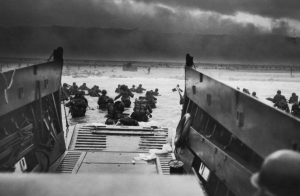 On this D-Day, a subject I have previously written about, I began to wonder about a different side of the story of this age old battle that everyone has heard of, even if some don’t know what it was all about. My thoughts turned to General Eisenhower. It was he who had the unfortunate task of deciding to attack the Germans who were occupying France, by way of the beaches of Normandy, France. It was he who had to carry the emotional burden of knowing that if the attack was made, he would be sending men to die. I would not have wanted to be in his shoes as he pondered this monumental decision. Nevertheless, someone had to make the decision. Things could not go on as they were. The future of the free world was dependent on the decisions made by this one man.
On this D-Day, a subject I have previously written about, I began to wonder about a different side of the story of this age old battle that everyone has heard of, even if some don’t know what it was all about. My thoughts turned to General Eisenhower. It was he who had the unfortunate task of deciding to attack the Germans who were occupying France, by way of the beaches of Normandy, France. It was he who had to carry the emotional burden of knowing that if the attack was made, he would be sending men to die. I would not have wanted to be in his shoes as he pondered this monumental decision. Nevertheless, someone had to make the decision. Things could not go on as they were. The future of the free world was dependent on the decisions made by this one man.
As families listened to their radio stations on the morning of June 6, 1944, one Valerie Lauder, who was 18 at the time, had graduated from Stephens Junior College that May and was not due at Northwestern University and the Medill School of Journalism until September was among the listeners. Her father was listening too, until he had to go to work. She said that President Roosevelt came on the radio and offered a prayer. Then, she heard General Eisenhower’s recorded reading of the order of the day, the troops in LSTs and transports heard it over loudspeakers. At that point, Val decided that she would really like to meet General Eisenhower, and given her chosen profession as a journalist, she was able to eventually make that happen. In fact, she was not only able to meet General Eisenhower 2½ years later, but was also able to preside at his press conference with the student press club that she had created and the Chicago Daily News sponsored.
She related the scene, “On January 18, 1947, Wearing two battle ribbons on his waist-length “Eisenhower jacket,” the supreme commander of the Allied Expeditionary Forces in Europe stood to my left, facing 165 student editors and photographers from high school and college newspapers throughout the greater Chicago area gathered in the Drake Hotel. Dressed in their Sunday best, pencils poised, notebooks open, they were seated on straight-back chairs set out in rows of 10 on either side of a center aisle. Ike stood at the end of the center aisle, about three feet in front of me. I introduced him.” As Val introduced General Eisenhower, she asked him, “General Eisenhower, what was the greatest decision you had to make during the war?” Eisenhower contemplated her question for a moment, and then answered her in a somber and serious tone about the D-Day landings. “To ensure the success of the Allied landings in Normandy,” he explained, “it was imperative that we prevent the enemy from bringing up reinforcements. All roads and rail lines leading to the areas of fighting on and around the beaches had to be cut or blocked. If reinforcements were allowed to reach the areas of fighting there, in our first, precarious attempts to get a foothold on the continent, the whole operation could be jeopardized. The landings might fail. The success of the landings on the beaches,” Ike said, reaching the end of the first row, starting back, “might well turn on the success of the paratroopers behind the lines.”
Then, on May 30, just six days before the scheduled landings, which were to have been June 5, a trusted aide and personal friend came to him, deeply concerned about the airborne landing. Val later that learned it was British Air Chief Marshal Sir Trafford Leigh-Mallory, who had been assigned to the Allied forces, with the title of Air Commander in Chief, which made him the air commander of the Allied invasion. He was apologetic about how late it was, so close to the jump-off time. But, he’d gone over it, and over it, and over it, and felt it simply would not succeed. The casualties would be too great. He pleaded with Eisenhower. “Casualties to glider troops would be 90% before they ever reached the ground,” he said. “The killed and wounded among the paratroopers would be 75%.” Eisenhower knew that would mean an unbearably high percentage of the 18,000 men who would drop into the darkness over Nazi-occupied France would become casualties. This would also mean that the survivors would be too few in number to succeed in their crucial mission of seizing, and holding the causeways. “The man was absolutely sincere, absolutely convinced it wouldn’t work,” Eisenhower said. “As a highly respected, capable officer, I trusted his judgment. I told him I’d think it over.”
After agonizing over the possible losses, he was still undecided just four days before the planned date. Eisenhower slowing, turned to face the students, he said, “I let the order stand.” With the words, his face seemed to relax. I suppose you would have to decide that you were going to be ok with the decision, or else it 
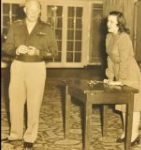 would drive you crazy. The students sat in stunned silence. “The airborne boys did their job.” Eisenhower went on with relief almost bordering on elation. “And, I am happy to say, the casualties were only 8%.” Eisenhower was not just a general setting up a battle, but rather a man with a heartfelt concern for the men in the airborne divisions and the men in the landing craft headed for the beaches. As he put it in his book, Crusade in Europe, “It would be difficult to conceive of a more soul-racking problem.” I have to agree. To only lose 8% of the men in that situation, well that is…unbelievable!!
would drive you crazy. The students sat in stunned silence. “The airborne boys did their job.” Eisenhower went on with relief almost bordering on elation. “And, I am happy to say, the casualties were only 8%.” Eisenhower was not just a general setting up a battle, but rather a man with a heartfelt concern for the men in the airborne divisions and the men in the landing craft headed for the beaches. As he put it in his book, Crusade in Europe, “It would be difficult to conceive of a more soul-racking problem.” I have to agree. To only lose 8% of the men in that situation, well that is…unbelievable!!

